Working with Decals and Projecting Textures
![]()
When working with decals, logos, or any other kind of projected texture, the first place to start is the texture. To add a texture to geometry, first assign the texture to a material. Depending on the type of texture, you can then drag and drop the material onto the geometry. For adding decals to surfaces, you need to additionally create a multi pass material, then add your texture material to the multi pass material before assigning it to geometry. After this, adjust the texture placement. Then, if the projection needs some depth, add a bump map.
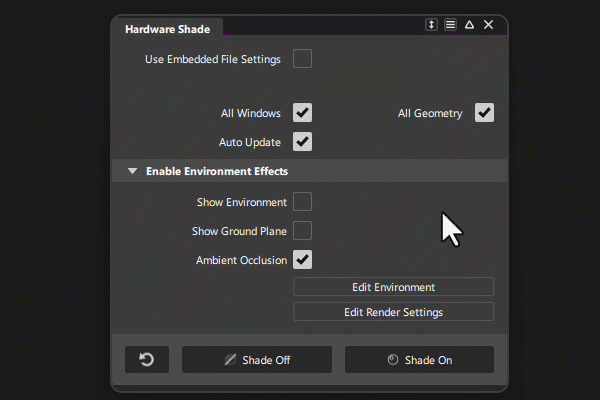
Unlike creating and modifying textures for Alias shaders, the Texture Editor is not used when creating textures with the VRED Renderer turned on. All the texture-related mapping attributes are accessible when the material is open in the Shader Editor.
Adding Decals to Surfaces
Adding a decal to your geometry is a two-step process. First you project an image onto a material to create the decal material. Then, you create a multi pass material and add your decal material along with the background material. You can then assign the multi pass material to your geometry and make any required adjustments to the decal's placement.
In the Shader Editor, create a default plastic material by selecting the New Shader icon
 , then select Plastic.
, then select Plastic.In the Diffuse Texture section, turn on Use Texture.
Set Mapping Type to Planar and the Repeat UV Mode options to Decal.
Tip: Rename this material so it's easily identifiable as your decal material. Depending on the position of your decal in the scene, there may not be a preview visible in the Shader Lister or Shader Editor. Locate and reposition the decal on shaded objects in step 8.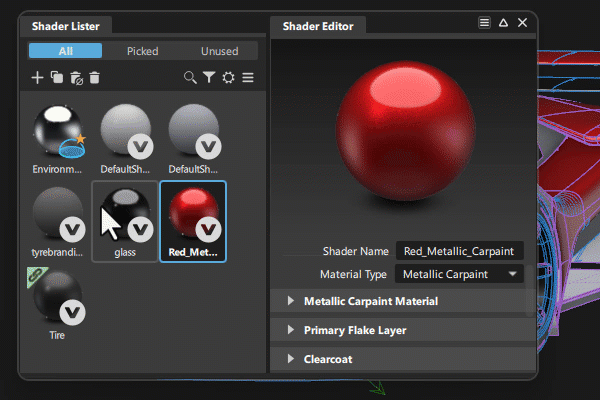
Click
 and select Multi Pass from the material list.
and select Multi Pass from the material list. Add materials to the multi pass by first dragging the decal material followed by the base material onto it.
Select the multi pass material, to display its attributes in the Shader Editor.
Important: Ensure that your decal material is at the bottom of the material list so that it displays on top of the base material.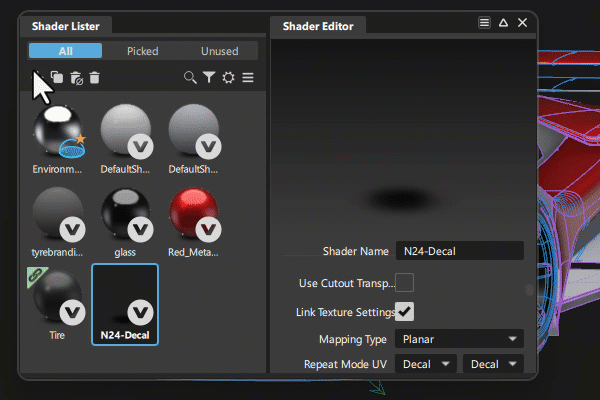
Assign the multi pass material to the surface by doing one of the following:
- MMB-drag the material from the Shader Lister onto the geometry.
- If another material is assigned to the geometry, select the assigned shader in the lister, then click the Pick Objects icon in the material's swatch. Next, select the material with the logo, then click the Assign to Objects icon.
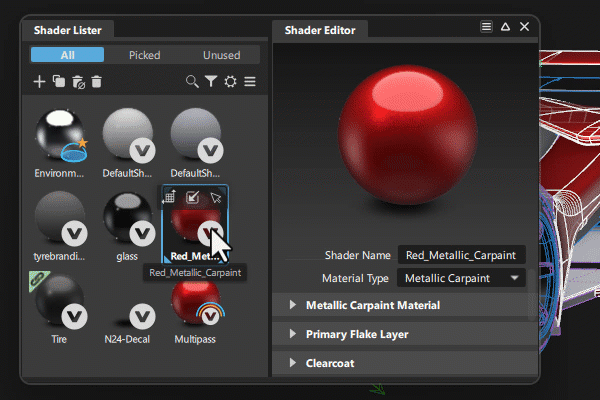
In the Shader Editor, select the decal material to display its attributes, then in the Diffuse Texture section, select Manipulate, and select the object to snap the manipulator to it.
You can now use the in-canvas manipulator to transform, rotate, and scale the decal. When satisfied with the placement, click Manipulate again to disable it.
Note: In some cases, when using the texture manipulator for the first time, clicking the proportional scale part of the manipulator may cause the Z Projection Size value to go to 0. This causes the texture to disappear from the view. When this happens, set the value to 100 or the desired value.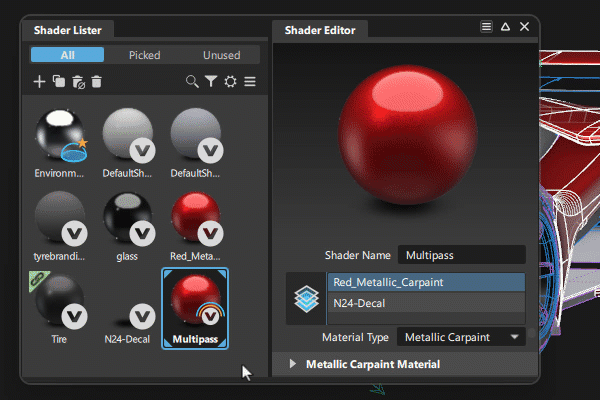
Mapping Texture Images onto a Material
- Create a plastic material.
- In the Diffuse Texture section, turn on Use Texture.
- Click the folder icon
 , locate your logo image, then click Open.
, locate your logo image, then click Open. - To assign the material, do one of the following:
- MMB-drag the material from the Shader Lister onto the geometry.
- If another material is assigned to the geometry, select the assigned shader in the lister, then click the Pick Objects icon in the material's swatch. Next, select the material with the logo, then click the Assign to Objects icon.
Next, we will work on adjusting the placement of the texture.
Adjusting Texture Placement
Use the Shader Editor Diffuse Texture attributes to fix the size, placement, alignment, and repetition of the logo or decal.
After setting the desired Mapping Type and Repeat Mode UV options, use the Projection Center, Projection Orientation, and Projection Size to define the orientation of the plane display. The Rotate slide control value defines the rotation in 2D around the plane normal.
For applying textures to a geometry with no UVs, use Triplanar. There is a blend zone where the projections overlap on the surface. If this does not give the desired result, actual UV coordinates need to be created, and UV must be used as the Mapping Type for the texture in the material.
For Incandescence, Transparency, and Displacement textures with radial and planar brush mapping, use UV.
For the planar placement of the logo text, use Projection Center.
To resize the logo, use Projection Size.
For adding a decal, see Adding Decals to Surfaces.
Click Fit Size to see the placement of the texture.
Click Manipulate to access the manipulator for transforming, rotating, and scaling your texture projection. When satisfied with the placement, click Manipulate again to disable it.
Note: In some cases, when using the texture manipulator for the first time, clicking the proportional scale part of the manipulator may cause the Z Projection Size value to go to 0. This causes the texture to disappear from the view. When this happens, set the value to 100 or the desired value.
Adding Depth
A bump map is used to add depth to the surface's projected content. When making a license plate for example, use the Bump Texture section to give it some depth.
- In the Bump Texture section, enable Use Texture.
- Click
 , locate the bump map for the plate, then click Open.
, locate the bump map for the plate, then click Open.
